What Types of Letters Are Best for Walls?
THE INSIDE SCOOP
What Types of Letters Are Best for Walls? It depends on a few factors. First, is it an interior or exterior wall? If it’s 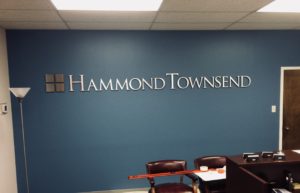 interior, there is an assortment of materials you can use that are potentially less expensive than those that have to withstand the elements for many seasons.
interior, there is an assortment of materials you can use that are potentially less expensive than those that have to withstand the elements for many seasons.
I recently lettered an interior wall for a law group that has multiple offices across Virginia. I had sold this customer similar interior wall signs as an account executive with Holiday Signs, and they continue to utilize me for signs now that I’m with Augusta Signs. They use a laminated acrylic letter for their interior corporate branding. Laminated letters are great for interior use, but they will eventually de-laminate outdoors and aren’t recommended for exterior applications. The particular style used had black edges and brushed silver laminated metal faces. They were stud mounted with spacers to cast a nice shadow from the office lighting. The customer painted the accent wall themselves and the rich blue background really sets off the lettering and makes for a very eye-catching branding statement!
recommended for exterior applications. The particular style used had black edges and brushed silver laminated metal faces. They were stud mounted with spacers to cast a nice shadow from the office lighting. The customer painted the accent wall themselves and the rich blue background really sets off the lettering and makes for a very eye-catching branding statement!
Generally speaking, labor costs to mount letters in drywall is often less than that required for exterior wall for letters (brick and concrete drilling), so material and labor costs for interior sign jobs are usually lower on the scale. That being said, there are some really neat options for interior letters that aren’t always available for outdoors, and some options will end up costing the same or more than exterior options. It all depends on the design.
Other options for interior wall letters: painted acrylic, acrylic with digitally printed laminated films, PVC, clear acrylic, wood, gilded letters, ACM.
 THE GREAT OUTDOORS
THE GREAT OUTDOORS
Now for exterior wall letters. I have been choosing and installing letters for wall signs since I started my career in the Department of Defense in 1980. Mostly, these types of letters nowadays are CNC cut, laser cut, injection-molded, or cast. Back when I first started I hand-cut wall letters, but it’s not my biggest strength. There was a lot of labor involved in cutting, filing, sanding, priming and painting. Today, I get most of my wall letter products from Gemini. I would guess that most sign companies do the same thing, so as you’re shopping for wall letters, ask for Gemini letters and the pricing should be reasonably close among the sign companies. Some may have a higher mark-up than others, but always consider the companies track record and things they may bring to the table above and beyond the competitors. A few things to look for: do they offer design services, and do they provide sketches that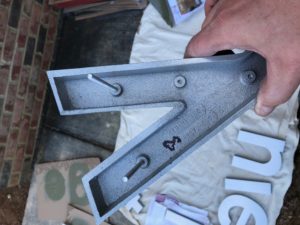 show how your letters will look an the wall? Do they provide final proofs for approval prior to production? What is their turn-around time? All Gemini letters and plaques come with a lifetime guarantee, another good reason to specify the Gemini brand, as do many architects.
show how your letters will look an the wall? Do they provide final proofs for approval prior to production? What is their turn-around time? All Gemini letters and plaques come with a lifetime guarantee, another good reason to specify the Gemini brand, as do many architects.
Today I completed an exterior wall sign for a local church. They are in the process of a sizable church renovation project and they wanted to set off the upgraded church facility by adding their name in wall letters as people come into church. The building committee wanted a letter style that was easy to read, so I recommended Gemini cast aluminum letters. They wanted a subtle look, so brushed aluminum seemed to fit the bill. They didn’t want insects or birds making a mess so extending them away from the wall wasn’t an option, thus I mounted the letters flush to the wall with hidden aluminum mounting studs. They will be spotlighting the sign at night with LED.
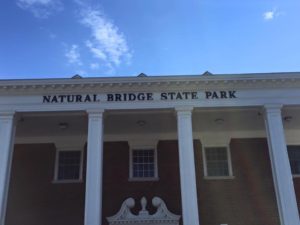 The most common options for exterior wall letters: Cast aluminum or bronze with natural satin finished or cast aluminum with painted finishes; Cut out aluminum with either natural or painted finishes; Cut out acrylic letters with painted finishes. All these types of letters are the best for walls.
The most common options for exterior wall letters: Cast aluminum or bronze with natural satin finished or cast aluminum with painted finishes; Cut out aluminum with either natural or painted finishes; Cut out acrylic letters with painted finishes. All these types of letters are the best for walls.
Mark Hackley is owner of Augusta Sign Company. Augusta Sign Company began in 1991 as Tree Street Ltd., then became The Roline Corporation in 2000. It traded as Tree Street Signs through early 2000, and began trading as Augusta Sign Company full-time in July 2015. In September, 2017 the company moved its shop from Waynesboro to Staunton. Call anytime: 540-943-9818.
 Window Signs- A Great Way to Get Attention! I’ve been lettering things that don’t move, and even a few things that do move, since I was a teenager. Glass windows are just one of the many surfaces that are prime real estate for signs.
Window Signs- A Great Way to Get Attention! I’ve been lettering things that don’t move, and even a few things that do move, since I was a teenager. Glass windows are just one of the many surfaces that are prime real estate for signs.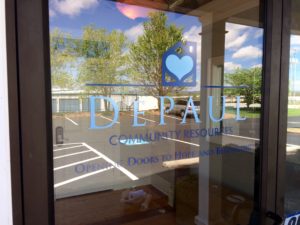 is good lighting in the room accommodating the doorway or window where the sign is installed; Specialty vinyls that appear to look like etched glass make nice choices as well, especially for professional office windows and doors.
is good lighting in the room accommodating the doorway or window where the sign is installed; Specialty vinyls that appear to look like etched glass make nice choices as well, especially for professional office windows and doors. penetrates through the best, you can’t go wrong by choosing white lettering for window and glass door lettering; but or course you can make them any color you like.
penetrates through the best, you can’t go wrong by choosing white lettering for window and glass door lettering; but or course you can make them any color you like.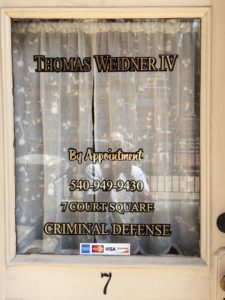
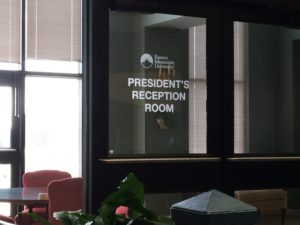 Gold leaf letters and white letters can really stand out, but sometimes you may want a more subtle look. This is the time you will want to consider etched letters. Ask your sign shop about “Etchmark” brand or similar vinyl sheeting in which you can cut your logos and letters, apply to the glass, and it looks like it was etched right in the glass.
Gold leaf letters and white letters can really stand out, but sometimes you may want a more subtle look. This is the time you will want to consider etched letters. Ask your sign shop about “Etchmark” brand or similar vinyl sheeting in which you can cut your logos and letters, apply to the glass, and it looks like it was etched right in the glass.
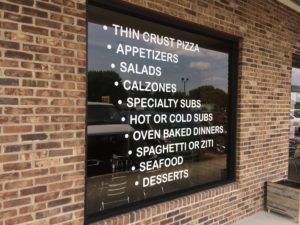
 replaced every month. Temporary window signs are great ways to keep people in touch with your business, especially if you’re located on a busy thoroughfare.
replaced every month. Temporary window signs are great ways to keep people in touch with your business, especially if you’re located on a busy thoroughfare. “How to finish a sandblasted sign?” is a question people may ask after seeing a sign of this type at a local business. In the early 1990’s I attended a hand-carved sign workshop taught by master sign carver, Jay Cooke. Lessons learned from that instructive workshop are still used in my sign-making and sign-finishing practices today.
“How to finish a sandblasted sign?” is a question people may ask after seeing a sign of this type at a local business. In the early 1990’s I attended a hand-carved sign workshop taught by master sign carver, Jay Cooke. Lessons learned from that instructive workshop are still used in my sign-making and sign-finishing practices today. companies, organizations, and individuals. These signs are frequently used as the primary identification signs for medical offices, parks and recreation sites, museums, resorts, theme parks, city entrances, churches, professional offices, bed and breakfasts, retail stores, and subdivision entrances, just to name a few.
companies, organizations, and individuals. These signs are frequently used as the primary identification signs for medical offices, parks and recreation sites, museums, resorts, theme parks, city entrances, churches, professional offices, bed and breakfasts, retail stores, and subdivision entrances, just to name a few.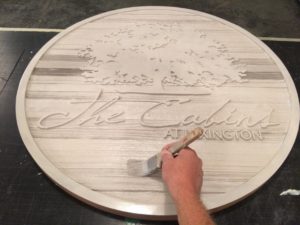 eye-catching sign:
eye-catching sign: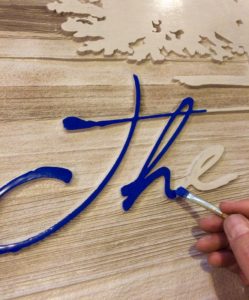 great all the time and last a life time.
great all the time and last a life time.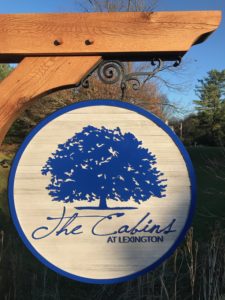 Next time you need a sign, consider a sandblasted wood sign!
Next time you need a sign, consider a sandblasted wood sign!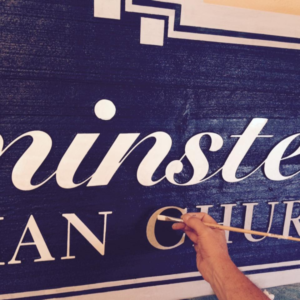 Budding Artist
Budding Artist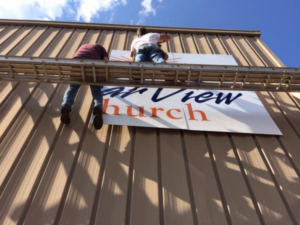 (now Middle School) where I was the artist for the school newspaper and yearbook. So it only made sense that by the time I reached High School it was appropriate that I be hired to paint the bass drum, which was a pretty challenging task for a guy used to pencil or pen and ink as a medium. I remember researching the proper paint to use for plastic surfaces. I wish I had a picture of the drum, but I don’t; But I do remember it was a success. The first of many successful sign projects!
(now Middle School) where I was the artist for the school newspaper and yearbook. So it only made sense that by the time I reached High School it was appropriate that I be hired to paint the bass drum, which was a pretty challenging task for a guy used to pencil or pen and ink as a medium. I remember researching the proper paint to use for plastic surfaces. I wish I had a picture of the drum, but I don’t; But I do remember it was a success. The first of many successful sign projects! scholarship to attend Maryland Institute College of Art in Baltimore, but declined to take a position as a sign apprentice instead with the US Navy in Bethesda, Maryland.
scholarship to attend Maryland Institute College of Art in Baltimore, but declined to take a position as a sign apprentice instead with the US Navy in Bethesda, Maryland.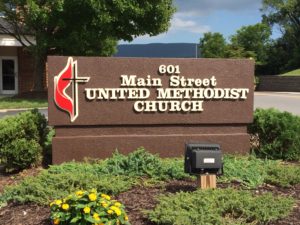 billboards, airport taxiways, insignias, vehicles, you name it!
billboards, airport taxiways, insignias, vehicles, you name it!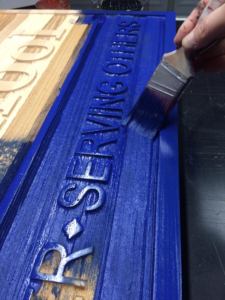 needing to get noticed and be profitable by increasing revenues; It has helped me realize and share this great gift, a gift that leaves a lasting impression everywhere I go. I’m forever passing signs all over the place that I put into service decades ago! It’s humbling to see all the work I was blessed with the ability to complete.
needing to get noticed and be profitable by increasing revenues; It has helped me realize and share this great gift, a gift that leaves a lasting impression everywhere I go. I’m forever passing signs all over the place that I put into service decades ago! It’s humbling to see all the work I was blessed with the ability to complete.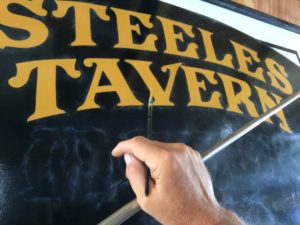 STAUNTON, VIRGINIA Mark Hackley, owner of Augusta Sign Company formerly of Waynesboro, Virginia has moved his sign shop to Augusta County, Virginia, near Staunton. So
STAUNTON, VIRGINIA Mark Hackley, owner of Augusta Sign Company formerly of Waynesboro, Virginia has moved his sign shop to Augusta County, Virginia, near Staunton. So  signage with his colleague Allen Gray around 1983. He then formed Kullman Signs with a friend, also on a part-time basis, around 1985. By 1987 Mark had formed Western Signs and Graphics and took out his first newspaper ad in the Laurel Leader. By 1988, Mark was married and he moved his business, still called Western Signs and Graphics, to Waynesboro, Virginia. He worked from home on a part time basis while working for Keeney and Company Architects of Charlottesville for about a year but before long, Mark began renting space above the former Doll Hospital on Wayne Avenue in Waynesboro later in 1988.
signage with his colleague Allen Gray around 1983. He then formed Kullman Signs with a friend, also on a part-time basis, around 1985. By 1987 Mark had formed Western Signs and Graphics and took out his first newspaper ad in the Laurel Leader. By 1988, Mark was married and he moved his business, still called Western Signs and Graphics, to Waynesboro, Virginia. He worked from home on a part time basis while working for Keeney and Company Architects of Charlottesville for about a year but before long, Mark began renting space above the former Doll Hospital on Wayne Avenue in Waynesboro later in 1988. where he remained for one full year. The business began to grow and Mark soon expanded to a larger facility in Crimora, Virginia, where he rented industrial space from Gary and Linda Scrogham of Scrogham Enterprises.
where he remained for one full year. The business began to grow and Mark soon expanded to a larger facility in Crimora, Virginia, where he rented industrial space from Gary and Linda Scrogham of Scrogham Enterprises.